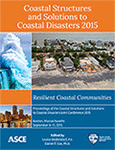Coastal Structures and Solutions to Coastal Disasters Joint Conference 2015
Structural Deflections from Wave Forces
Publication: Coastal Structures and Solutions to Coastal Disasters 2015: Resilient Coastal Communities
ABSTRACT
Coastal design guidance is available to estimate structural forces caused by waves breaking against vertical surfaces. Studies have been made to evaluate forces created by these significant hydrodynamic transient forces. Studies on both rigid wall and scale-model wood structures from wave impacts have shown that there is a time delay between the initial wave contact and the peak deflection recorded. This delay is generally consistent for individual systems and structures, regardless of wave size or orientation. The purpose of this study is to review existing literature and to evaluate possible explanations for this phenomenon observed in wave tank studies at OSU (Oregon State University). It is proposed that structural response to wave impact loads is analogous to that created by seismic events. Following theories are proposed based on literature review and analyses. These are required to be confirmed through additional research. 1. Structures respond to coastal wave impacts similar to forces created by seismic events. Buildings or walls respond to wave forces based on natural or fundamental frequencies of structural systems impacted. 2. Building uplift forces and horizontal deflection vary based on wave characteristics, but the time to the peak response does not. Waves generate negative acceleration upon initial impact. The presence of water around the structure after impact appears to dampen the deceleration phase. 3. Normalized equations are developed that predict deflections and time to peak. The fundamental deflection equation appears to be primarily a function of a peak kg value, gravity coefficient, and time. The harmonic portion of the equation is a cubic parabola function of the natural frequency of the impacted structural system. 4. A peak kg function determines magnitude of deflection and appears to be predominantly a sigmoidal curve distribution function of the structures inertia and wave heights. Oscillation frequencies create minor transients as structures and waves interact. These findings if expanded and validated by further research can simplify wave force analysis for onshore coastal structures. It can also potentially reduce damages to structures and resulting financial losses due to storm surge.
Get full access to this article
View all available purchase options and get full access to this chapter.
WORKS CITED
ASCE (American Society of Civil Engineers). (2014) Minimum Design Loads for Buildings and Other Structures, Standard ASCE/SEI 7-10. Third printing. ASCE, Reston, VA.
FEMA (Federal Emergency Management Agency). (1999) FIA-TB-9, Design and Construction Guidance for Breakaway Walls Below Elevated Coastal Buildings.
FEMA Mitigation Assessment Team. (2006) “Report on Hurricane Katrina in the Gulf Coast,” JFO Briefings Presentation, 99.
FEMA. (2011) P-55, Coastal Construction Manual Principles and Practices of Planning, Siting, Designing, Constructing, and Maintaining Residential Buildings in Coastal Areas. Fourth Edition. Volumes I, II & CCM Resources Manual.
FEMA. (2009) P-550, Recommended Residential Construction for Coastal Areas Building on Strong and Safe Foundations. Second Edition.
Filiatrault, A, I. Christovasilis, A. Wanitkorkul, and J.W. van de Lindt. (2010). “Experimental Seismic Response of a Full-Scale Light-Frame Wood Building”, ASCE Journal of Structural Engineering, 136(3), 246-254.
Hattori, M., A. Arami, T. Yui. (1994) “Wave impact pressure on vertical walls under breaking waves of various types,” Coastal Engineering (22)1-2, 79-114.
Lugni, C., M. Miozzi, and M. Brocchini. (2010) “Evolution of the air cavity during a wave impact,”.
Miles, J. (2007). “Surge impact loading on wood residential structures,” Proceedings of the 2007 Earthquake Engineering Symposium for Young Researchers.
Sutoyo, D. (2009). “Hysteretic characteristics of wood-frame structures under seismic motions,” Dissertation (Ph.D.), CIT,.
van de Lindt, J.W., R. Gupta, R. Garcia, and J. Wilson. (2009). “Tsunami Bore Forces on a Compliant Residential Building Model.” Engineering Structures, 31, 2534-2539.
van de Lindt, J.W., A. Graettinger, R. Gupta, T. Skaggs, S. Pryor, and K. Fridley. (2007). “Performance of Woodframe Structures During Hurricane Katrina.” ASCE Journal of Performance of Constructed Facilities; 21(2), 108-116.
White, K.B.D., T. H. Miller, R. Gupta. (2009). “Seismic performance testing of partially and fully anchored wood-frame shear walls,” Wood and Fiber Science, 41(4), 396-413.
Wilson, J.S., R. Gupta, J.W. van de Lindt, M. Clauson, and R. Garcia. (2009).“Behavior of a One-Sixth Scale, Wood-Framed Residential Structure Under Wave Loading.” ASCE Journal of Performance of Constructed Facilities, 23 (5), 336-345.
Wilson, J.S., R. Gupta, J.W. van de Lindt, and D.T. Cox. (2010). “Behavior of Wood-Framed Residential Structure Under Surge Wave Loading.” 11th World Conference on Wood Engineering, Trentino, Italy, June 2010.
Wu, N.T., H. Oumeraci, H.W. Partenscky (1994). “Numerical Modelling of Breaking Wave Impacts on a Vertical Wall,” Coastal Engineering, 1672-1686.
Information & Authors
Information
Published In
Coastal Structures and Solutions to Coastal Disasters 2015: Resilient Coastal Communities
Pages: 610 - 618
Editors: Louise Wallendorf, U.S. Naval Academy and Daniel T. Cox, Ph.D., Oregon State University
ISBN (Online): 978-0-7844-8030-4
Copyright
© 2017 American Society of Civil Engineers.
History
Published online: Jul 11, 2017
Published in print: Jul 11, 2017
Authors
Metrics & Citations
Metrics
Citations
Download citation
If you have the appropriate software installed, you can download article citation data to the citation manager of your choice. Simply select your manager software from the list below and click Download.
